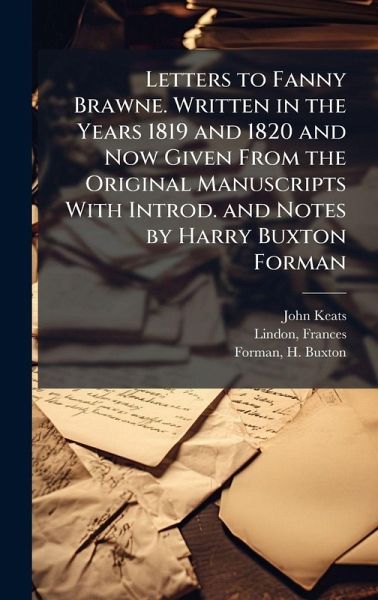
Letters to Fanny Brawne. Written in the Years 1819 and 1820 and Now Given From the Original Manuscripts With Introd. and Notes by Harry Buxton Forman
Versandkostenfrei!
Versandfertig in über 4 Wochen
30,99 €
inkl. MwSt.

PAYBACK Punkte
15 °P sammeln!
A collection of intimate letters written by the renowned Romantic poet John Keats to Fanny Brawne during the years 1819 and 1820. This edition, meticulously compiled and introduced by Harry Buxton Forman, presents the original manuscripts, offering readers a direct and unedited glimpse into Keats's thoughts, emotions, and daily life during a pivotal period in his career and personal life. The letters reveal the depth of Keats's affection for Brawne, his struggles with illness, and his reflections on poetry and the world around him. This volume provides invaluable insights into the mind of one ...
A collection of intimate letters written by the renowned Romantic poet John Keats to Fanny Brawne during the years 1819 and 1820. This edition, meticulously compiled and introduced by Harry Buxton Forman, presents the original manuscripts, offering readers a direct and unedited glimpse into Keats's thoughts, emotions, and daily life during a pivotal period in his career and personal life. The letters reveal the depth of Keats's affection for Brawne, his struggles with illness, and his reflections on poetry and the world around him. This volume provides invaluable insights into the mind of one of English literature's most celebrated figures and the woman who captured his heart. Letters to Fanny Brawne remains a poignant testament to enduring love and artistic passion. These letters are essential reading for scholars, students, and anyone captivated by the beauty of Keats's verse and the tragic romance that defined his final years. This work has been selected by scholars as being culturally important, and is part of the knowledge base of civilization as we know it. This work was reproduced from the original artifact, and remains as true to the original work as possible. Therefore, you will see the original copyright references, library stamps (as most of these works have been housed in our most important libraries around the world), and other notations in the work. This work is in the public domain in the United States of America, and possibly other nations. Within the United States, you may freely copy and distribute this work, as no entity (individual or corporate) has a copyright on the body of the work. As a reproduction of a historical artifact, this work may contain missing or blurred pages, poor pictures, errant marks, etc. Scholars believe, and we concur, that this work is important enough to be preserved, reproduced, and made generally available to the public. We appreciate your support of the preservation process, and thank you for being an important part of keeping this knowledge alive and relevant.


